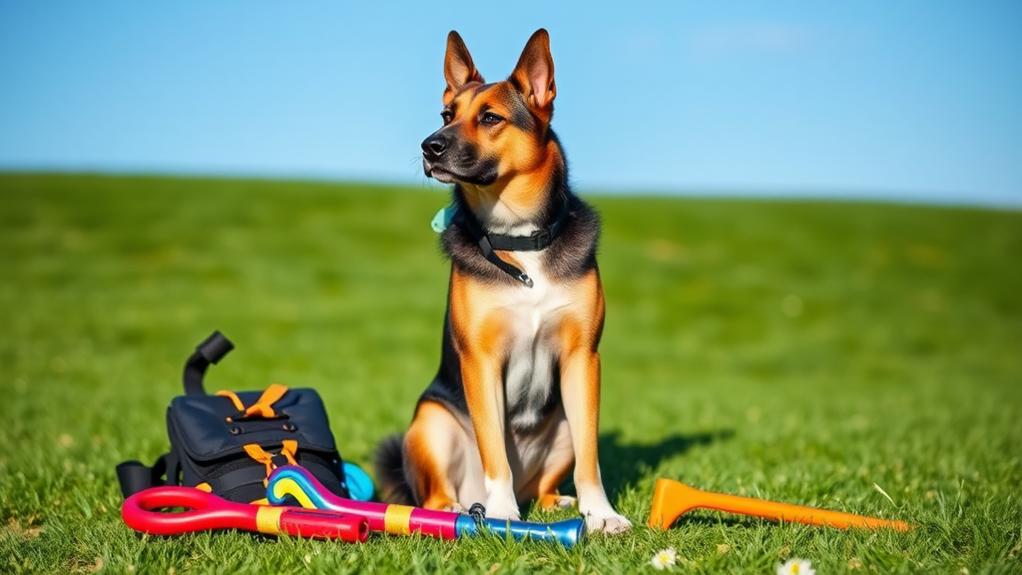To proof your dog's behavior effectively, start with a solid foundation by teaching essential commands consistently. Introduce mild distractions gradually, ensuring your dog can focus in increasingly challenging environments. Use positive reinforcement like treats and praise to reward desired behaviors immediately. Consistently apply cues for specific actions and create a predictable reward system. Don't forget to practice in real-world scenarios, like busy parks or friends' homes, to reinforce good behavior amidst distractions. These techniques will help your dog become reliable and well-adjusted. Keep exploring to uncover even more strategies for successful training!
Understanding Proofing Basics
Understanding proofing your dog's behavior is essential for ensuring they respond reliably in various situations. Proofing involves exposing your dog to different environments, distractions, and scenarios to reinforce their training. It's not enough for your dog to perform commands in a quiet room; you need to practice in parks, around other dogs, and during busy times to solidify their skills.
Start by introducing mild distractions and gradually increase the difficulty as your dog becomes more confident. For instance, if your dog knows how to sit, practice it while other dogs are playing nearby. This helps your dog learn to focus on you despite distractions. Consistency is key—use the same cues and rewards to reinforce desired behaviors.
Establishing a Reliable Foundation

Establishing your dog's reliable foundation is essential for successful proofing. This foundation guarantees that your dog understands basic commands and behaviors before introducing distractions or challenges. Focus on teaching your dog fundamental skills consistently and effectively.
Consistency: Use the same commands and cues every time. This helps your dog grasp what you expect, making it easier for them to respond reliably.
Positive Reinforcement: Reward your dog with treats, praise, or playtime when they perform the desired behavior. This encourages them to repeat those actions.
Short Training Sessions: Keep training sessions brief and engaging to maintain your dog's focus. Aim for 5-10 minutes several times a day to reinforce learning without overwhelming them.
Gradual Exposure to Distractions
Introducing distractions during training is crucial for helping your dog generalize their skills in real-world situations. By gradually exposing your dog to distractions, you can build their focus and reliability. Start in a controlled environment and slowly introduce various distractions, like noises, moving objects, or other animals. This process allows your dog to learn to concentrate despite external stimuli.
Distraction Type | Training Location
—————–|———————
Low-level noise | Quiet backyard
Moving objects | Park with few people
Other dogs | Dog park during off-peak hours
Crowded areas | Busy street or market
As you progress, increase the difficulty level of the distractions. Always reward your dog for maintaining focus, even in challenging situations. Patience is key—if your dog struggles, take a step back and reduce the distractions. This gradual approach helps your dog develop confidence and reinforces the skills you've taught them, ensuring they can perform reliably in any environment.
Consistent Reinforcement Techniques

Consistency is key when it comes to reinforcing your dog's behavior. When you use consistent reinforcement techniques, your dog learns what actions lead to positive outcomes. It's essential to be clear and predictable so your dog understands what you expect from them. Here are some effective ways to maintain consistency in your training:
- Use the same cues: Make sure you always use the same commands or signals for specific behaviors. This helps your dog connect the cue with the desired action.
- Apply reinforcement immediately: Give praise or treats right after your dog performs the desired behavior. This timing helps them link their action with the reward.
- Be consistent with rewards: If you reward a behavior one time and not the next, your dog may become confused. Stick to a consistent reward system, whether it's treats, praise, or playtime.
Utilizing Positive Reinforcement

When it comes to shaping your dog's behavior, utilizing positive reinforcement can make a significant difference in your training success. This technique focuses on rewarding your dog for desired behaviors, encouraging them to repeat those actions. Instead of punishing unwanted behavior, you'll find that reinforcing the positive helps build a trusting and enjoyable relationship.
Start by identifying the behaviors you want to encourage. Whether it's sitting on command or walking calmly on a leash, consistency is key. Use treats, praise, or playtime as rewards. When your dog performs the desired behavior, immediately offer the reward to reinforce the connection. Timing matters! The quicker you reward, the clearer the message.
It's also important to vary your rewards. Mixing up treats, toys, and affection keeps your dog engaged and motivated. As your dog learns, you can gradually reduce the frequency of rewards, shifting to intermittent reinforcement. This helps solidify the behavior while keeping your dog keen to earn rewards.
Practicing Real-World Scenarios

After establishing a foundation with positive reinforcement, it's time to apply those learned behaviors in real-world scenarios. Practicing in various environments helps your dog generalize commands and respond consistently, regardless of distractions. Start by gradually introducing your dog to different settings, ensuring they remain comfortable and focused.
Consider the following scenarios to practice:
- Walking in a busy park: Use this setting to reinforce leash manners and recall. The presence of other dogs and people will test your dog's attention.
- Grocery store parking lot: This environment introduces new sounds and sights. Practice sit and stay while you move around, rewarding your dog for staying calm and in place.
- Friends' homes: Socializing with other pets and people provides excellent opportunities for practicing commands and impulse control in a more chaotic setting.
In each scenario, remain patient and consistent. Use treats and praise to reinforce good behavior. By regularly practicing in diverse environments, you'll help your dog adapt and respond reliably to commands, setting the stage for a well-behaved companion in any situation.
Conclusion
By understanding proofing basics and establishing a reliable foundation, you're well on your way to a well-behaved dog. Gradually exposing your pup to distractions while consistently reinforcing good behavior and utilizing positive techniques will strengthen their skills. Remember to practice real-world scenarios to guarantee your dog can handle various situations with ease. With patience and dedication, you'll create a confident companion ready to respond to your commands, no matter the environment. Keep training fun and rewarding!



